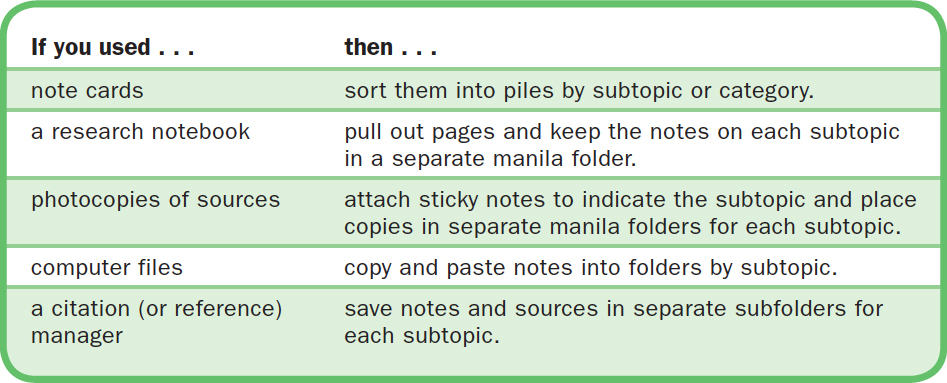ORGANIZING YOUR RESEARCH PROJECT
Your first step in organizing your research project is deciding what you’ll say and the order in which you will say it. Think about which pattern of organization — chronological, spatial, most-to-least or least-to-most, or one of the patterns of development discussed in Chapters 11-21 of this text — will allow you to convey your ideas most effectively. As you plan your organization, think about the best ways to use sources to support those ideas. Creating a list of synthesis categories or a synthesis graphic organizer can be helpful in this regard. (For more on using categories or a graphic organizer to synthesize ideas, see Chapter 23.)
In the planning stage, keep the paper’s required length in mind. Many essay assignments can be completed in three or four pages, but your research assignment might require a paper of ten, fifteen, or even twenty pages. Can you get enough mileage out of your topic and organization? If you think your current plan may not yield a long enough paper, consider using another pattern of development to explore another facet of the topic. For example, you might be able to write an effective extended definition essay on the topic of home-schooling, but for a lengthy research project on home-schooling you may need not only to define the term but also to compare or contrast home-schooling with public education, to explore the reasons parents choose to home-school their children or the effects of home-schooling (cause-effect), and so on. Below are some additional guidelines for organizing your research paper.
ARRANGING YOUR NOTES
Start by considering your thesis or the categories you identified while synthesizing your notes. Then list the subtopics you want to explore in your research project, and arrange your research notes into these categories. For example, files for the thesis “Prekindergarten programs provide children with long-lasting educational advantages” might be sorted by type of educational advantage, such as reading readiness, social skills, and positive self-image.

Regardless of the medium in which you worked, be careful to keep track of which material belongs to which source as you rearrange your notes. Once your notes are organized by subtopic, you are ready to develop your outline or graphic organizer.
DEVELOPING AN OUTLINE OR GRAPHIC ORGANIZER
Use an outline or a graphic organizer to show how you plan to arrange the divisions and subdivisions you intend to use. (For more on creating outlines and graphic organizers, see Chapter 7.) Preparing such a plan is especially important for a research project because you are working with a substantial amount of information. Without something to follow, it is easy to get lost and write an unfocused paper.
Learning Style Options
Pragmatic learners tend to prefer organizing in detail before they begin to write. If this is your tendency, make sure that you are open to change and new ideas as you write your draft. Creative learners, in contrast, may prefer to start writing and try to structure the paper as they work. Most students should not take this approach, however; those who do should allow extra time for reorganizing and making extensive revisions.
Whatever your learning style, writing an outline or sketching a graphic organizer can help you test several different organizations. Be sure to save your original outline or graphic organizer and any revised versions as separate files in case you need to return to earlier versions.
Research Project in Progress 6
Using the synthesis categories or graphic organizer that you developed for Research Project in Progress 5, sort your notes into categories and evaluate your working thesis. Then prepare an outline or a graphic organizer for your research project.